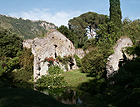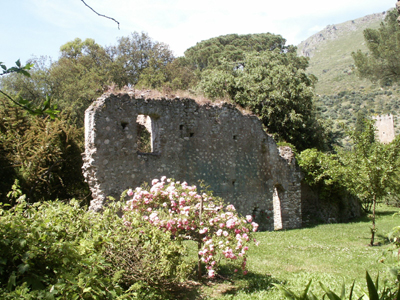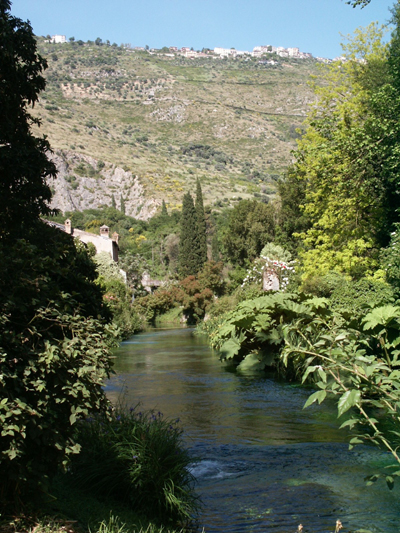The Garden of Ninfa, Italy
Isobel Walsh pays a visit to a gem of a garden which has grown up among the ruins of a medieval town in southern Italy


The Garden of Ninfa is a romantic oasis of fertility in the midst of the heavily-industrialised Pontine Plain to the South East of Rome. Set amongst the ruins of the medieval town of Ninfa, the garden sits, emerald-like, at the feet of the scorched Lepini Hills.
In the arid conditions of the summer heat, it remains green and lush -combining a wealth of flora and fauna to create an intense atmosphere of colour, fragrance and natural beauty.Ninfa dates from Roman times, and in the 9th Century it became a frequent stopping place for travellers between Rome and Naples.
It flourished, reaching its heyday in the late 13th Century, when the Caetani pope Boniface VIII bought the town, and gave it to his nephew Pietro Caetani. Under his stewardship, the town continued to expand and prosper well into the 14th Century.Disaster struck, however, in 1382, when Ninfa fell into the hands of neighbouring armies during the Great Schism of the Catholic Church, and the town was razed.
The few survivors were eventually driven out by Malaria, which infested the nearby Pontine Marshes. Attempts were made to repopulate the town, and in the seventeenth century Francesco Caetani, Viceroy of the Two Sicilies, cultivated tulips and planted citrus fruits in a formal garden - which can still be seen today.Caetani descendants began to revisit Ninfa in the early 1900s, and to clear the ruined site. Thus began the transformation of the ruins into a botanical oasis. Three generations of Caetani women were largely responsible, starting with the English-born Ada Wilbraham Caetani who planted rose-cuttings against the walls of the ruins of the town during picnics there in the 1920s.

The garden owes much of its English character to Ada's granddaughter Lelia Caetani, the last of the line, who carried on work here until her death in 1977. Today, Ninfa is owned and managed by the Roffredo Caetani Foundation, which was set up for this purpose by Lelia and her husband Hubert Howard.It is the ruins of the town - churches, castle and town hall - rather than any formal layout, that provide the framework for the garden. Ancient streets are used to create avenues of cypress and lavender, and the stonework itself acts as support for roses, clematis, and a wealth of other climbing plants.

Through a still intact medieval gateway, the dappled light of an immaculately-planted orchard of citrus fruit opens up into an enticing vista, while the overpowering fragrance of lemon and orange assaults your senses. Elsewhere, the scent of sun-kissed roses, honeysuckle and wild mint catches you unawares, drawing your gaze skywards to visions of climbing roses poking through the branches of cypress trees, and honeysuckle draped lazily over the tops of ruined walls.
The complex water system in the garden is its lifeblood, and is responsible for the intense greenery. It rushes in from under the mountains, and gurgles and plays its way around and about the creative canalisation around the garden before cascading into the river, once called Nymphaeus (since its spring was dedicated to the nymphs in Roman times). A Roman temple is said to lie at the bottom of the lake.
Exquisite houses, the beauty of Nature, and how to get the most from your life, straight to your inbox.

At night, the magic intensifies. The trill of several pairs of nightingales rises above the background babble of water, while glow-worms and fireflies light the way through the maze of plants and ruins.The Caetani Foundation has lobbied hard to extend its environmental influence in the region, and has recently established a 200-acre nature reserve stretching from Ninfa out into the Pontine Plain, where the richness of the flora and fauna has also earned it the protection of the World Wildlife Fund, too. Much of this conservation area has been restored to its origins as marshland and lakes, with the aim of attracting migrating birds and mammals, and encouraging the growth of rare plant species.
Public openings are on the first Saturday and Sunday of each month from April to October; and the third Sunday of April, May and June. Times of opening are 0900 -1200 and 14.30 - 1800 except for July and August when the afternoon openings are from 1500 to 18.30.For the latest visitor information, please call: (0039) 0773 633935 or Email:fondazione.caetani@libero.it
Country Life is unlike any other magazine: the only glossy weekly on the newsstand and the only magazine that has been guest-edited by His Majesty The King not once, but twice. It is a celebration of modern rural life and all its diverse joys and pleasures — that was first published in Queen Victoria's Diamond Jubilee year. Our eclectic mixture of witty and informative content — from the most up-to-date property news and commentary and a coveted glimpse inside some of the UK's best houses and gardens, to gardening, the arts and interior design, written by experts in their field — still cannot be found in print or online, anywhere else.
